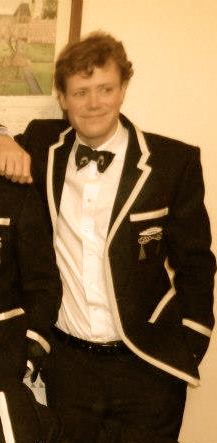
Databases: Bookshelf · CGDB · KDB · OMPDB · Lipidbook | Links | Contact | Intranet | Search
 |
|
Home |
Mission |
Research |
Members |
Positions |
Image Gallery |
Panoramas |
Seminars Databases: Bookshelf · CGDB · KDB · OMPDB · Lipidbook | Links | Contact | Intranet | Search |
Matthias Schmidt |
|
Structural Bioinformatics and Computational Biochemistry Unit Dept. of Biochemistry University of Oxford South Parks Road Oxford OX1 3QU U.K. Telephone: 01865 613304 Fax: 01865 613238 e-mail: matthias.schmidt@chch.ox.ac.uk |
 |
Homology modeling and simulations of twin pore potassium and inward rectifiers | |
Background |
I studied physics in Munich and Sydney and have spent over a year in the Netherlands at Philips Research working on medical devices and optical biosensors before joining the Industrial Doctorate Centre at the University of Oxford in September 2009. I came to the SBCB for a D.Phil. in September 2010. My research is funded by Pfizer and the Engineering and Physical Sciences Research Council. I am jointly supervised by Prof Mark Sansom and Dr Stephen Tucker. |
Research |
|
|
Twin pore channels TREK and TRESK Twin pore channels are responsible for regulating the resting membrane potential. My interest is in modelling the structure of K2P channels.Kir channels Kir channels underlie important physiological processes. Renal and kidney function, hormone secretion, neuronal and cardiac excitability are affected by mutations in Kir channels which lead to inheritable diseases, such as Bartter's symtpom and diabetes. Kir channels open and close in response to ligands binding to the channel, a process known as gating. My research attempts to understand aspects of the gating and regulation process by using coarse grained and atomistic molecular simulations. | |
Publications |
|
|
Simulation-Based Prediction of Phosphatidylinositol 4,5-Bisphosphate Binding to an Ion Channel. Matthias R. Schmidt, Phillip J. Stansfeld, Stephen J. Tucker, Mark S.P. Sansom (Biochemistry, 2012) doi:10.1021/bi301350s. Article chosen by the editor to be highlighted on the journal's home page. State-Independent Intracellular Access of Quaternary Ammonium Blockers to the Pore of TREK-1. Markus Rapedius (*), Matthias R. Schmidt (*), Chetan Sharma, Phillip J. Stansfeld, Markus Rapedius, Mark S.P. Sansom, Thomas Baukrowitz, Stephen J. Tucker (Channels, 2012) doi: 10.4161/chann22153. Structure of a KirBac Potassium Channel with an Open Bundle-Crossing Indicates a Mechanism of Channel Gating. Vassily N. Bavro, Rita de Zorzi, Matthias R. Schmidt, Joao R.C. Muniz, Lejla Zubcevic, Mark S.P. Sansom, Catherine Venien-Bryan, Stephen J. Tucker (Nature Structure and Molecular Biology, 2012) doi: 10.1038/nsmb.2208 Featured in PSI Nature "Research Advances section" for March 2012 doi: 10.1038/sbkb.2011.66 The wire grid biosensor for nucleic acid testing. Matthias R. Schmidt. Philips Technical Note, July 2009. Optical Spectroscopy on Joints for Rheumatoid Arthritis. Matthias R. Schmidt. Philips Technical Note, February 2006. (*) denotes joint first authorship | |
| Last updated 6 May 2013 |